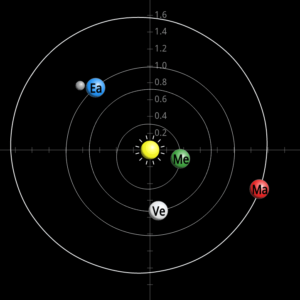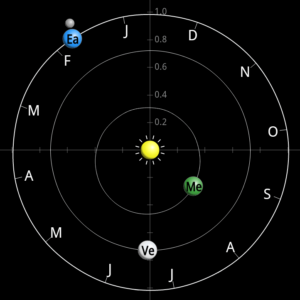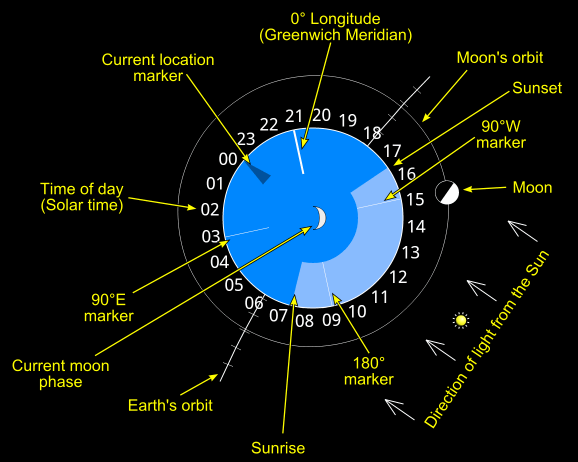Intro
This view shows the locations of the Planets and their orbits around the Sun as viewed from the ‘top’ of the Solar System.

- Tap the Planet symbols at the bottom of the screen to select a Planet and zoom to fit its orbit on screen.
- The orbits are drawn to scale with respect to each other, but the Planet symbols themselves are simple markers (if they were drawn at the same scale as their orbits they would be practically invisible on a small phone screen!).
- When the Sun is the selected object the view will default to showing the Inner Planets (ie Mercury to Mars).
Earth Orbit
When the Earth is selected then markers are also displayed around the orbit to highlight the 1st of each month of the year. Note also that the 4 points where the axes cross the orbit signify the exact points in the year of the Winter Solstice (Top), Summer Solstice (Bottom), Vernal Equinox (Left) and Autumnal Equinox (Right).

Moon Orbit
When the Moon is selected the view changes quite drastically to show an enlargement of the Moon and its orbit around the Earth. Extra detail is also shown on the Earth itself to indicate its daily rotation and how this relates to your location, time and daylight hours. The following diagram labels the different parts of the view:

There are a number of interesting concepts that can be visualised using this view, in particular:
- The numbers around the edge of the Earth show the hour of the day with respect to the direction of the light coming from the Sun. Midday (12pm) is therefore always facing the sun, and midnight (12am) is always on the opposide side, facing out into space.
- The Current Location marker is taken from your longitude. The Earth spins anti-clockwise (when viewed from above, as it is in this view) so as your location slowly rotates with the Earth’s spin is passes through each hour of the clock.
- The light-blue area depicts the hours of daylight, calculated from your Latitude and the time of year. As your location rotates and passes from the dark-blue into the light-blue, this signifies Sunrise, whereas moving from light-blue to dark-blue signifies Sunset.
- To simplify the diagram, the Earth’s tilt on its axis is not shown, but it is included in all calculations.
- As the Earth rotates around the Sun in its yearly cycle
